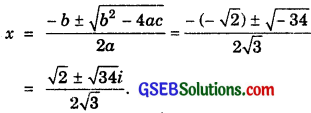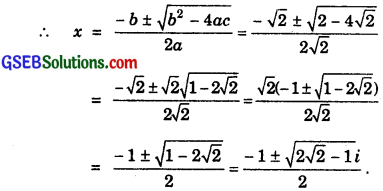Gujarat Board GSEB Textbook Solutions Class 11 Maths Chapter 5 Complex Numbers and Quadratic Equations Ex 5.3 Textbook Questions and Answers.
Gujarat Board Textbook Solutions Class 11 Maths Chapter 5 Complex Numbers and Quadratic Equations Ex 5.3
Solve each of the following equations:
1. x2 + 3 = 0
2. 2x2 + x + 1 = 0
3. x2 + 3x + 9 = 0
4. – x2 + x – 2 = 0
5. x2 + 3x + 5 = 0
6. x2 – x + 2 = 0
7. \(\sqrt{2}\)x2 + x + \(\sqrt{2}\) = 0
8. \(\sqrt{3}\)x2 – \(\sqrt{2}\)x + 3\(\sqrt{3}\) = 0
9. x2 + x + \(\frac{1}{\sqrt{2}}\) = 0
10. x2 + \(\frac{x}{\sqrt{2}}\) + 1 = 0.
Solutions to questions 1 to 10:
1. x2 + 3 = 0 ⇒ x2 = – 3
∴ x = ±\(\sqrt{- 3}\) = ±\(\sqrt{3i}\).
2. 2x2 + x + 1 = 0.
Comparing with ax2 + bx + c = 0,
a = 2, b = 1, c = 1.
∴ b2 – 4ac = 12 – 4.2.1 = 1 – 8 = – 7
∴ x = \(\frac{-b \pm \sqrt{b^{2}-4 a c}}{2 a}\) = \(\frac{-1 \pm \sqrt{-7}}{2.2}\) = \(\frac{-1 \pm \sqrt{7} i}{4}\).
![]()
3. x2 + 3x + 9 = 0
∴ a = 1, b = 3, c = 9
∴ b2 – 4ac = 32 – 4.1.9
= 9 – 36
= – 27.

4. – x2 + x – 2 = 0 or x2 – x + 2 = 0.
Here, a = 1, b = – 1, c = 2.
∴ b2 – 4ac = (- 1)2 – 4.1.2
= 1 – 8 = – 7.
∴ x = \(\frac{-b \pm \sqrt{b^{2}-4 a c}}{2 a}\) = \(\frac{-1 \pm \sqrt{-7}}{2.1}\) = \(\frac{-1 \pm \sqrt{7} i}{2}\).
![]()
5. x2 + 3x + 5 = 0
∴ a = 1, b = 3, c = 5.
∴ b2 – 4ac = 9 – 4.1.5 = 9 – 20 = – 11.

6. x2 – x + 2 = 0
∴ a = 1, b = – 1, c = 2.
∴ b2 – 4ac = (- 1)2 – 4.1.2 = 1 – 8 = – 7.
∴ x = \(\frac{-b \pm \sqrt{b^{2}-4 a c}}{2 a}\) = \(\frac{-1 \pm \sqrt{-7}}{2.1}\) = \(\frac{-1 \pm \sqrt{7} i}{2}\).
![]()
7. \(\sqrt{2}\)x2 + x + \(\sqrt{2}\) = 0
∴ a = \(\sqrt{2}\), b = 1, c = \(\sqrt{2}\).
∴ b2 – 4ac = 12 – 4(\(\sqrt{2}\).\(\sqrt{2}\)) = 1 – 8 = – 7.
∴ \(\frac{-b \pm \sqrt{b^{2}-4 a c}}{2 a}\) = \(\frac{-1 \pm \sqrt{-7}}{2 \cdot \sqrt{2}}\) = \(\frac{-1 \pm \sqrt{-7} i}{2 \sqrt{2}}\).
8. \(\sqrt{3}\)x2 – \(\sqrt{2}\)x + 3\(\sqrt{3}\) = 0
∴ a = \(\sqrt{3}\), b = – \(\sqrt{2}\), c = 3\(\sqrt{3}\).
∴ b2 – 4ac = (- \(\sqrt{2}\))2 – 4.\(\sqrt{3}\).3\(\sqrt{3}\) = 2 – 36 = – 34.

9. x2 + x + \(\frac{1}{\sqrt{2}}\) = 0, Multiplying by \(\sqrt{2}\), we get
\(\sqrt{2x}\) + \(\sqrt{2x}\) + 1 = 0.
∴ a = \(\sqrt{2}\), b = \(\sqrt{2}\), c = 1.
∴ b2 – 4ac = (\(\sqrt{2}\))2 – 4.\(\sqrt{2}\).1 = 2 – 4\(\sqrt{2}\).

![]()
10. x2 + \(\frac{x}{\sqrt{2}}\) + 1 = 0
Multiplying by \(\sqrt{2}\), we get
\(\sqrt{2}\)x2 + x + \(\sqrt{2}\) = 0.
∴ a = \(\sqrt{2}\), b = 1, c = \(\sqrt{2}\)
∴ b2 – 4ac = 12 – 4\(\sqrt{2}\).\(\sqrt{2}\) = 1 – 8 = – 7.
∴ x = \(\frac{-b \pm \sqrt{b^{2}-4 a c}}{2 a}\) = \(\frac{-1 \pm \sqrt{-7}}{2 \sqrt{2}}\) = \(\frac{-1 \pm \sqrt{7} i}{2 \sqrt{2}}\).